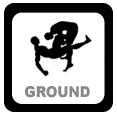Ground Style Martial Arts:
 Includes martial arts such as Brazilian Jiu-Jitsu, shoot wrestling, catch wrestling, Judo and Sambo are trained to improve ground control and position, as well as to achieve submission holds, and defend against them.
Includes martial arts such as Brazilian Jiu-Jitsu, shoot wrestling, catch wrestling, Judo and Sambo are trained to improve ground control and position, as well as to achieve submission holds, and defend against them.
Ground-and-pound
Ground-and-pound is a ground fighting tactic consisting of taking an opponent to the ground using a takedown or throw, obtaining a top, or dominant position, and then striking the opponent, primarily with the fists. Ground-and-pound is also used as a precursor to attempting submission holds.
This style is used by wrestlers or other fighters well-versed in submission defense and skilled at takedowns. They take the fight to the ground, maintain a grappling position, and strike until their opponent submits or is knocked out. Although not a traditional style of striking (it was first demonstrated as an effective technique by UFC and Pride grand prix champion, Mark Coleman), the effectiveness and reliability of ground-and-pound has made it a popular tactic. Today, strikes on the ground are an essential part of a fighter’s training.
Submission Grappling
Apart from being a general martial arts term, submission grappling is also a reference to the ground fighting tactic consisting of taking an opponent to the ground using a takedown or throw and then applying a submission hold, forcing the opponent to submit. While grapplers will often work to attain dominant position, some may be more comfortable fighting from other positions. If a grappler finds themselves unable to force a takedown, they may resort to pulling guard, whereby they physically pull their opponent into a dominant position on the ground.
Submissions are an essential part of many disciplines, most notably catch wrestling, judo, Sambo, pankration, Army Combatives, MCMAP and Brazilian Jiu-Jitsu. They were popularised in early UFC by Ken Shamrock and Royce Gracie.
Lay-and-pray
Lay-and-pray is a pejorative term for a strategy whereby a fighter can control their opponent on the ground, but is unable to mount an effective offense. They simply seek to negate the offense of their opponent, “praying” for a decision victory. In some promotions, penalties may be imposed for lay-and-pray techniques if the referee determines that a fighter is stalling.
Follow Us
Stay up-to-date with the latest from Find MMA Gyms.
NO THANKS, I'M NOT INTERESTED.